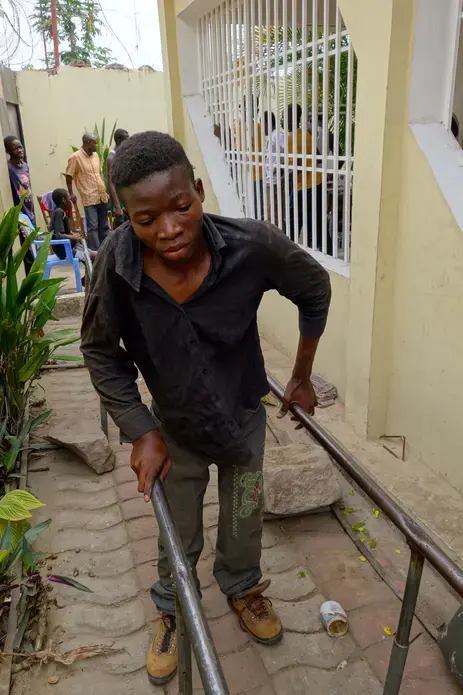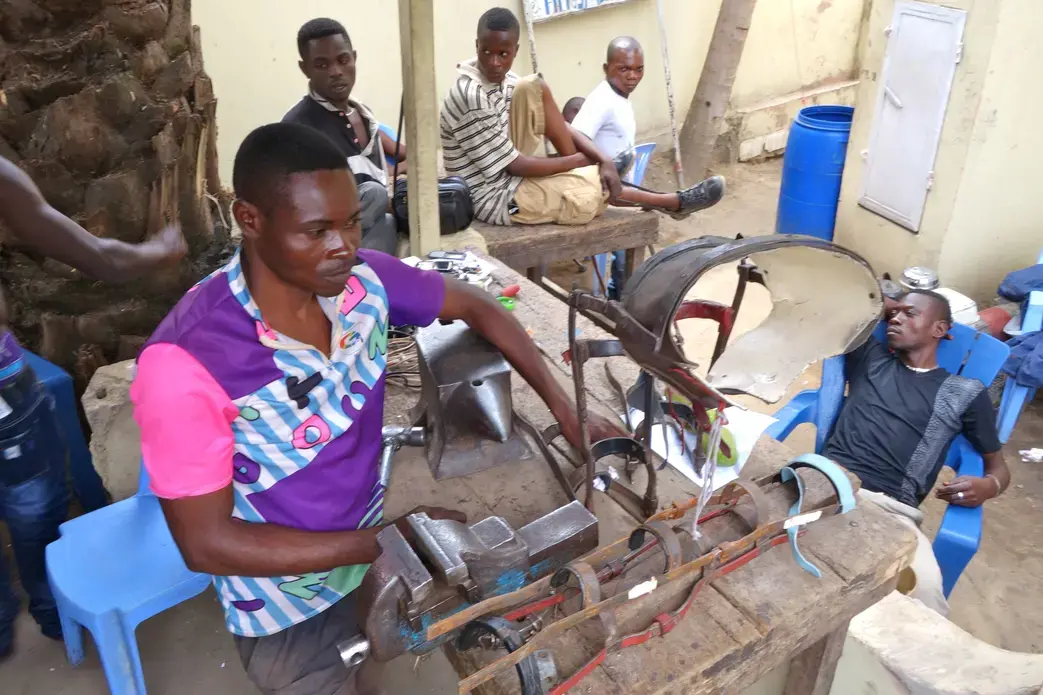(Photographs by Jon Sawyer and Kem Knapp Sawyer)
CONGO, Africa—The boys in red-and-blue-striped jerseys race across the field—their eyes fixated on the bright yellow ball as sweat drips from their brows. Palm trees border one side of the playing field while the Congo River ripples behind; it's a gorgeous setting for a soccer game. On the other side a road cuts through Kinshasa's tony embassy neighborhood. Many of the locals have taken to jogging there, and some enjoy being spectators at today's match.
If you look at the boys only from the waist up, you might think this was just another soccer game. It is not. The players have braces on their legs—some are short to support just the ankle, others longer for knee and hip support. A few players hit the ball with their crutches.
The team players live in the Ngaliema neighborhood in a small compound run by an organization called StandProud. This nonprofit supports Congolese children with physical disabilities such as polio. The center now houses 35 boys and young men, ages 5 to 23; several staff members are graduates of the program.
For polio, one of the world's worst scourges, these are end days. Since the launch of the Global Polio Eradication Initiative in 1988, 2.5 billion children have been immunized. The number of new cases has plummeted from 350,000 in 1988 to less than 400 in 2013. The Democratic Republic of Congo (DRC) has made great strides too, and is no longer listed among the dwindling numbers of country where polio is still endemic (Afghanistan, Nigeria, and Pakistan).
Yet the risk of contracting polio still exists, especially in areas where vaccines are rarely administered. According to the Global Polio Eradication Initiative, as many as 8 to 12 percent of Congolese children under the age of five are unvaccinated. Some parents avoid vaccination programs out of fear or for religious reasons.
The boys with their braces and crutches are a reminder that behind the global success is a generation left behind, and those with polio and other physical disabilities are too often consigned to lives at the margin. StandProud has stood up for them—and with them—in centers where the victims of diseases like polio learn to care for each other. StandProud is a US registered non-profit as well as a UK charity that partners with a Congolese organization called ACDF (Association Congolaise Debout et Fier). For 14 years the two groups have worked together, and they now have centers in six locations across Congo.
Futila, a 15-year-old resident at StandProud, has two braces and has just learned to walk using an outdoor ramp. Méchak, who is uncertain of his age but must be younger than eight, contracted konzo, a disease resulting from cassava poisoning that paralyzes the legs. Brossy, 15, underwent surgery in a hospital that was paid for by StandProud. He now has a plaster cast to straighten his leg. It will become less painful as it heals. Obed, a 16-year-old with polio, has been at the center since 2010. His legs must also be straightened before he can receive braces. He has developed painful pressure sores from his plaster casts.
"The time that it takes for healing depends on the mental attitude. It takes longer for some," says StandProud supervisor Chérif Mohamed, who is from Ivory Coast.
A few of the StandProud residents never leave. They learn to fabricate braces for the newcomers and join the staff once they become adults—passing on their skills. The young men buy scrap metal from a shop in town. The leather is imported from the U.S.
The center has electricity, some comfortable furniture, including a couch and several chairs. The brace craftsmen share one room; the others find places to sleep throughout the compound. They have mattresses but still need sheets and curtains. There is a small kitchen with running water—bread is provided in the morning and a meal of beans and meat at midday.
Tony Gambino, a Zaire Peace Corps volunteer from the early 1980s and former USAID mission director for the DRC, says of StandProud that "the energy and beauty of what they do is just phenomenal. They've helped thousands of children and young adults. Kids have a tremendous sense of pride and accomplishment. They've been given options."
The 2013 State of the World's Children, a report published by UNICEF, focuses on children with disabilities and the many barriers that keep them from leading full lives. The report states that those with disabilities who also live in poverty are the ones who suffer most—least likely to attend school, sometimes shunned by their families.
Children with physical disabilities are "among the last in line for resources and services, especially where these are scarce to begin with," writes Anthony Lake, executive director of UNICEF. "The inclusion of children with disabilities in society is possible—but it requires first a change of perception, a recognition that children with disabilities hold the same rights as others."
Making these children visible has always been a priority for StandProud. They help enroll them in schools with non-physically disabled students, paying the school fees when possible.
StandProud was the brainchild of Jay Nash, now the senior humanitarian advisor for USAID's Office of US Foreign Disaster Assistance in Congo. "Jay has built something magnificent," his friend Tony Gambino said. "You can look at it and really feel good about it."
Nancy Bolan, deputy director of IMA World Health, an international public health organization in Kinshasa, works with Jay on strategic planning and fundraising (also visiting with the kids, and organizing games and parties). They are reeducating teachers, parents, and the community so that everyone can recognize the benefits of inclusion.
Funding remains a constant struggle. Donors and NGOs from the US, Germany, the UK, and Switzerland contribute, but few grants are long-term. Bills must be paid—the rent for the Kinshasa center is $900 a month. Also needed are funds for staff salaries, school fees, food, uniforms, and school supplies.
The StandProud center in Goma in eastern Congo presents another set of challenges. Welthungerhilfe, a German NGO, secured the purchase of land for a brand-new compound in the Katindo neighborhood. The South African contingent of MONUSCO (the UN Organization Stabilization Mission in the DRC) has helped with the construction of a residence to accommodate up to 90 residents.
The new building boasts a large living room with double doors, a room for physiotherapy, two dorm rooms that will sleep 14 to 20 children each, a smaller bedroom for older students, and another room for the volunteers. Across the street is a church with a large playing field. A primary school and a secondary school are next door.
However, the building project has yet to be completed. Funding for the latrines and solar power must still be procured. For now, the youth in Goma remain at the old center. And the MONUSCO peacekeepers continue to help out—sometimes organizing a weekend party.
Linda Lukambo grew up in Walikale, a mineral-rich and war-torn region in North Kivu province. At the age of five he contracted polio. The pain that he felt in his legs prevented him from walking so his mother had to carry him wherever he went. It took an entire year for him to learn to "walk" on his knees.
In 2007, when Lukambo was 15, his father brought him to StandProud in Goma. He has had three operations, does physical therapy, and is steadily making progress. He now works as the assistant brace technician.
"I am very content," he says. "My father, mother, three sisters, and three brothers come to visit me."
Not all of the children in residence have polio. One boy is suffering from a war wound—his legs became paralyzed after he was shot. Some were born with a club foot or cerebral palsy; for others the disabilities are a result of disease or medical mistreatment. One child became paralyzed after receiving a quinine injection in the hip, once considered a safe way to cure malaria.
On a Saturday afternoon they gather with staff members, residents, neighbors, and MONUSCO peacekeepers for an outdoor party. They set up a boom-box, drink sodas, and enjoy the noontime sun.
One boy throws his crutches to the side, does a handstand, and twirls—not just once or twice but half a dozen times. Another bends his knees, leans on one hand, throws his legs out and turns, all the while keeping time to the music. People applaud and cheer, and before long everyone there is up and dancing, too.
This article was also published by Truth Atlas on March 26, 2014.























































